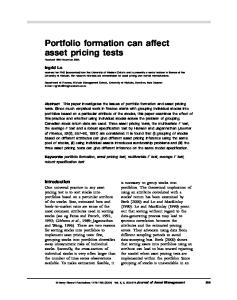Continuous-Time Asset Pricing Theory A Martingale-Based Approach
Yielding new insights into important market phenomena like asset price bubbles and trading constraints, this is the first textbook to present asset pricing theory using the martingale approach (and all of its extensions). Since the 1970s asset pricing the
- PDF / 4,745,672 Bytes
- 457 Pages / 439.42 x 683.15 pts Page_size
- 40 Downloads / 370 Views
Robert A. Jarrow
Continuous-Time Asset Pricing Theory A Martingale-Based Approach
Springer Finance Textbooks
Editorial Board Marco Avellaneda Giovanni Barone-Adesi Mark Broadie Mark Davis Emanuel Derman Claudia Klüppelberg Walter Schachermayer
Springer Finance Textbooks Springer Finance is a programme of books addressing students, academics and practitioners working on increasingly technical approaches to the analysis of financial markets. It aims to cover a variety of topics, not only mathematical finance but foreign exchanges, term structure, risk management, portfolio theory, equity derivatives, and financial economics. This subseries of Springer Finance consists of graduate textbooks.
More information about this series at http://www.springer.com/series/11355
Robert A. Jarrow
Continuous-Time Asset Pricing Theory A Martingale-Based Approach
123
Robert A. Jarrow Samuel Curtis Johnson Graduate School Cornell University Ithaca New York, USA
ISSN 1616-0533 ISSN 2195-0687 (electronic) Springer Finance Springer Finance Textbooks ISBN 978-3-319-77820-4 ISBN 978-3-319-77821-1 (eBook) https://doi.org/10.1007/978-3-319-77821-1 Library of Congress Control Number: 2018939163 Mathematics Subject Classification (2010): 90C99, 60G99, 49K99, 91B25 © Springer International Publishing AG, part of Springer Nature 2018 This work is subject to copyright. All rights are reserved by the Publisher, whether the whole or part of the material is concerned, specifically the rights of translation, reprinting, reuse of illustrations, recitation, broadcasting, reproduction on microfilms or in any other physical way, and transmission or information storage and retrieval, electronic adaptation, computer software, or by similar or dissimilar methodology now known or hereafter developed. The use of general descriptive names, registered names, trademarks, service marks, etc. in this publication does not imply, even in the absence of a specific statement, that such names are exempt from the relevant protective laws and regulations and therefore free for general use. The publisher, the authors and the editors are safe to assume that the advice and information in this book are believed to be true and accurate at the date of publication. Neither the publisher nor the authors or the editors give a warranty, express or implied, with respect to the material contained herein or for any errors or omissions that may have been made. The publisher remains neutral with regard to jurisdictional claims in published maps and institutional affiliations. Printed on acid-free paper This Springer imprint is published by the registered company Springer International Publishing AG part of Springer Nature. The registered company address is: Gewerbestrasse 11, 6330 Cham, Switzerland
This book is dedicated to my wife, Gail.
Preface
The fundamental paradox of mathematics is that abstraction leads to both simplicity and generality. It is a paradox because generality is often thought of as requiring complexity, but this is not true. This insight explains bo
Data Loading...











